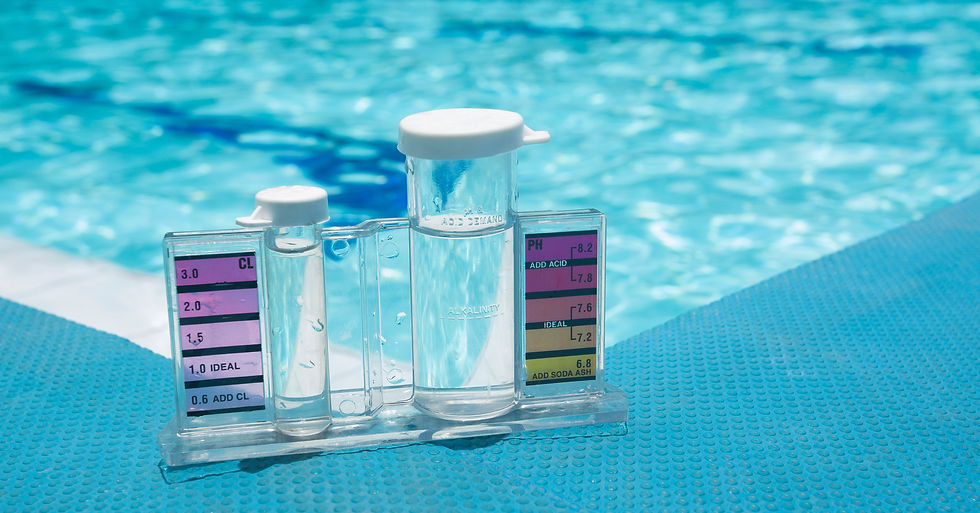Chlorine (Cl): Properties, Hazards & Uses
- Sylvia Rose

- Nov 8, 2024
- 5 min read
Updated: Nov 9, 2024
Chlorine (Cl) is a vital element in nature, used in industry as a disinfectant. Characterized by its highly reactive habits, chlorine is a pale yellow-green gas at room temperature and has a distinct, sharp odor. A friendly element, it readily forms compounds with others.

Discovery of Chlorine
Chlorine is an important element in experiments carried of medieval alchemists. Experiments include heating chloride salts like ammonium chloride (sal ammoniac) and sodium chloride (common salt).
This results in the creation of different chemical compounds containing chlorine such as hydrogen chloride, mercury(II) chloride (corrosive sublimate), and aqua regia. Around 1630 Jan Baptist van Helmont identifies free chlorine gas as a distinct substance.

Chlorine is officially discovered in 1774 by Swedish-German chemist Carl Wilhelm Scheele. He produces it by heating hydrochloric acid with manganese dioxide, creating a greenish-yellow gas he refers to as "dephlogisticated muriatic acid."
In 1809 Sir Humphry Davy recognizes it as a distinct element and named it "chlorine," derived from the Greek word "chloros," meaning green. As a highly reactive element, chlorine is used in creating chemical compounds, especially in water treatment.

Properties & Characteristics of Chlorine
Chlorine (Cl) is a chemical element with atomic number 17. It's part of the halogen group in the periodic table, with fluorine, bromine, iodine, and astatine.
Characterized by its yellow-green color and sharp odor, chlorine primarily exists in nature as chloride ions in seawater. About 55% of Earth's chlorine is found in the ocean.

Chlorine is known for several distinct properties:
Physical State: Chlorine exists as a diatomic gas (Cl₂) at room temperature, which has a pale yellow-green appearance. Its boiling point is -34.04 °C, and its melting point is -101.5 °C.
Color and Odor: Chlorine gas has a greenish-yellow color and a strong, pungent odor that can be irritating to the eyes and respiratory system.
Density: Chlorine is denser than air, which means it can accumulate in lower areas if released.
Reactivity: As a highly reactive non-metal, chlorine readily reacts with alkali metals, alkaline earth metals, and organic compounds. Chlorine's reactivity comes from its high electronegativity, particularly strong compared to many other elements.
Solubility: Chlorine is soluble in water but less so in organic solvents.

When mixed with water, chlorine creates hydrochloric acid (HCl) and hypochlorous acid (HClO). Over 20% of the chlorine put into water for treatment is converted into hypochlorous acid, effective in killing pathogens.
Toxicity: Chlorine gas is hazardous; even small amounts can cause respiratory issues, eye irritation, and skin burns. Concentrated exposure can be lethal.

Hazards of Chlorine or Its Compounds
While chlorine is essential in many applications, it poses several hazards:
Health Risks: Chlorine exposure can cause irritation and severe burns to the respiratory tract, eyes, and skin. Inhaling high concentrations can lead to collapse and death.
Environmental Impact: Chlorine and its compounds can lead to environmental pollution. For example, chlorine is often associated with the formation of dioxins, harmful pollutants that can affect wildlife.
Chlorine Gas: Being a toxic gas, chlorine can be dangerous in industrial settings. In reaction with organic materials, it can lead to hazardous compounds and explosions if not properly managed.
Reactivity: Incorrect handling of chlorine can lead to dangerous situations. For example, mixing chlorine with ammonia results in toxic chloramine gases, harmful to humans and other animals.

Historical & Modern Uses of Chlorine & Its Compounds
Water Treatment: Chlorine is commonly used to disinfect drinking water, significantly reducing the prevalence of waterborne diseases. Chlorination contributes to a more than 80% decline in deaths from cholera and typhoid.
Household Products: Chlorine compounds, such as bleach (sodium hypochlorite), are widely used as disinfectants for cleaning and laundry.
Industry: Chlorine is critical in the manufacture of various chemicals, including plastics (like PVC), solvents, and pharmaceuticals. In the paper industry, chlorine compounds are used to bleach wood pulp.

Pharmaceuticals: Chlorinated compounds are crucial in developing pharmaceuticals, contributing both antibacterial properties and improved drug effectiveness. More than 50% of modern medicines contain chlorine in their molecular structures.
Pest Control: Chlorinated pesticides have transformed agriculture, enhancing crop yields. However, environmental concerns regarding their toxicity have led to stricter regulations over recent decades.
Biodiesel Production: Recently, innovations in renewable energy technologies have incorporated chlorine in biodiesel production, underlining its adaptability to new fields.

Facts About Chlorine
Chlorine is the second lightest halogen, just after fluorine.
Industrially, chlorine is produced through the electrolysis of sodium chloride, yielding chlorine gas.
Chlorine helps break down ozone in the stratosphere.
Despite its hazards, chlorine is one of the most widely used chemicals worldwide, emphasizing its critical role in public health and sanitation.
Natural Abundance: Chlorine is the second most abundant halogen on Earth, accounting for approximately 0.17% of the Earth's crust.
Odor Detection: Chlorine’s sharp odor allows for detection at very low concentrations, even just parts per million, helping identify leaks and ensure workplace safety.
Chlorine vs. Chlorides: While chlorine gas is toxic, many of its compounds, particularly chlorides, are safe. Sodium chloride (table salt) is essential for human health and is a staple in food preparation.
Green Chemistry: The scientific community is actively working toward reducing the environmental impact of chlorine in industrial applications through advancements in green chemistry solutions.
Reaction Speed: Chlorine is one of the fastest-reacting elements. Some reactions can occur in fractions of a second, especially under specific conditions.

Non-Fiction Books:
Fiction Books:
READ: Lora Ley Adventures - Germanic Mythology Fiction Series
READ: Reiker For Hire - Victorian Detective Murder Mysteries


